#Commodore 64 exclusive
Text

Requested by anon
#Uuno Turhapuro muuttaa maalle#Commodore 64 exclusive#video games#gaming#video game polls#polls#tumblr polls#side scroller
35 notes
·
View notes
Text
youtube
Bird Mother is a captivating action game exclusive to the Commodore 64, developed and published by Creative Sparks, a division of Thorn EMI Video Ltd., around 1984. In this game, players embody a diligent mother bird, tasked with the vital goals of protecting and nurturing her chicks. The gameplay unfolds across three distinct stages, each presenting its own set of challenges.
In the initial stage, players are tasked with catching twigs tumbling from the sky to construct a nest for laying eggs. This task must be accomplished while dodging other falling objects, as collisions result in the loss of a life. The second stage shifts focus to foraging, requiring players to catch worms and return them to the nest to feed the awaiting chicks. This level introduces a new hazard: avoiding a stick hurled by a man annoyed by the player's competition for the worms. The primary challenge anyway lies in ensuring each chick is fed three times before time expires, a task complicated by the elusive nature of the insects.
The game reaches its climax in the third and final stage, where the player teaches the fledglings to fly. Managing the chicks' altitude is crucial; allowing them to fly too high or too low risks losing them from view or exposing them to a predatory bird - A particularly demanding level, as the chicks tend to scatter, requiring vigilant guidance to keep them safe and within sight. Eventually, memorizing their movement patterns enables players to guide the chicks back to the nest as proficient flyers.
My personal recollection of Bird Mother centers not only on its straightforward yet demanding gameplay but also on its unique premise. The game beautifully encapsulates the essence of maternal instinct—protection and provision. This aspect alone distinguishes the Creative Sparks release as a memorable - albeit less heralded - contribution to the diverse and rich gaming heritage of the Commodore 64 era.
#retro gaming#retro gamer#retro games#video games#gaming#old school gaming#back to the past#I want to go back#those were the days#good old days#bird mother#c64#commodore 64#action games#old gamer#gaming videos#youtube video#longplay#gamer for ever#gamer for life#Youtube
2 notes
·
View notes
Text
I've been working on a new game for the Commodore 64! It's a multiplayer (split-screen) adventure game called Stranded Cats 🐱
A demo is available on Patreon, where I also write exclusive weekly update posts about all this and other projects. Feel free to check it out here: www.patreon.com/siegfriedcroes
Music: Nothing but PETSCII by Stinsen (Johan Samuelson)
#Stranded Cats#pixel art#game development#retro gaming#commodore 64#c64#cats of tumblr#screenshot saturday
5 notes
·
View notes
Text

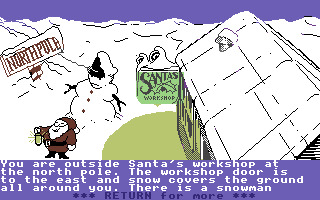
Merry Christmas From Melbourne House (Commodore 64)
Developed/Published by: Melbourne House
Released: 1984
Completed: 11/12/2023
Completion: Beat it with a score of 100 out of 100.
It’s 1984 and the Christmas cash-in market is finally mature, with five whole games released for home computers (at the very least.) Alphabetically first in my list (because Icon Software chose to go with “Xmas” on their merry release) Merry Christmas From Melbourne House is a slight cheat because it’s really just a tiny tech demo/bit of marketing, but it was sold, costing 95p (the price of tape duplication and postage?) for readers of Commodore User (it was actually in the December issue and the deadline was December 17th to get your money to them, which makes me wonder how many people played this long after things stopped being festive.)
It is though, honestly, what I was kind of expecting from A Christmas Adventure. It’s a short, very easy little adventure game that… passes about half an hour and actually manages to feel Christmassy.
Like A Christmas Adventure, you’re tasked with making sure Santa can get away from the north pole to deliver presents, but in a shocking twist… YOU are Santa. The game’s blurb claims he’s “attempting to stop an industrial dispute” that “is threatening the delivery of toys to children of the world” and it sounds like jolly old saint nick is a fat cat like the rest of ‘em, and out of solidarity with the elves and workers everywhere I spent quite a bit of time typing things like “GIVE ELVES RAISE” and “PROVIDE TIME OFF” but the parser never understood it, so I almost didn’t finish this.
The plot is a bit oversold anyway, considering the solution is pretty much “Get off your fat arse and pack your sack of toys yourself, Santa.”
As you’re not doing all that much, the parser is adequate, and the graphics are… genuinely quite evocative. They are important too–the toys you have to pack are all on one screen. I don’t generally like this design in graphic text adventures–where you don’t get told everything in text (I’m a VERBOSE man in Infocom games)–and having to work out directions here was not my favourite, But it worked well enough, and I was even charmed by the full screen advert for Melbourne House games.
Anyway, lemme see how much 95p is in today’s money. £3.77. I can’t really say people got their money’s worth here, but they could do a lot worse.
Will I ever play it again? I’m good.
Final Thought: Joe Pranevich over at The Adventurer’s Guild played through this as well if you’d like to read something more in-depth about it, with the bonus that one of the developers, Dave Johnston, shows up in the comments, revealing that it was developed “in a matter on weeks using an in-house text engine and a tweaked sprite engine based on Way of the Exploding Fist code” and that he didn’t even have a copy. They paid people at Melbourne House so poorly that they couldn’t raise 95p???
Support Every Game I’ve Finished on ko-fi! You can pick up a digital copy of exp. 2600, a zine featuring all-exclusive writing at my shop, or join as a supporter at just $1 a month and get articles like this a week early.
#gaming#video games#games#txt#text#review#commodore 64#c64#merry christmas from melbourne house#melbourne house#christmas#1984
2 notes
·
View notes
Text
An Introduction to Emulation
There are a lot of really cool old games, but actually playing them can seem quite difficult. Fortunately, there are tools available that make old games much more accessible. The most powerful, by far, is emulation. If you have ever wanted to learn how to play classic video games that aren't available on modern platforms, this post is for you.
TLDR: Emulation recreates old hardware (like game consoles) using software, allowing games to be played on modern systems. It's an incredibly cool technology that, while it has some minor downsides, is overall an important tool for preserving game history and enabling new game experiences.
What is the issue?
Game companies don't always make their older titles easily playable on modern hardware. There are so many important, influential, and fun video games released on older hardware that can't be bought on any modern platform. In fact, game companies sometimes go out of their way to remove their titles from modern storefronts. After Bandai Namco released Dark Souls Remastered in 2018, the original version of Dark Souls was removed from Steam, presumably to encourage people to buy the newer, shinier, more expensive release. Game history is important, and it's incredibly rewarding to engage with. Unfortunately, if you limit yourself to what is only available through official channels like Nintendo Switch Online, Steam, GoG, Xbox, Playstation 5, you will miss out on a lot of cool games.
Games are often designed to operate on very specific hardware. Games made for the N64 can't run on a Sony Playstation, and vice versa. Even on PC, a platform which is generally much more customizable, games can be made obsolete through software updates and new operating system releases. Software's dependency on hardware makes it harder to access as technology progresses. Because of this dependency on specific hardware, it takes a non-trivial amount of effort to keep games "up to date", and often companies decide it isn't worth the effort. I can still read books from the 1500s because fundamentally, they are just words and those are easy to bring to modern formats. Film too is relatively easy to keep functional. As long as you have a device that can run mp4 files, you have a lot of options with regards to how you watch a movie (even if those files have to come from an unofficial source). This isn't to imply that lost media and preservation challenges don't exist for books or movies, but the fact that I can easily access books that are several decades old, but many influential console games released even in the past few decades aren't playable on natively modern hardware says a lot. Fortunately, we have a solution. Emulation
What is emulation?
Emulation is software that performs the same function as hardware. Put simply, it lets games designed for one platform run on another. For instance, Dolphin is an emulator designed to play GameCube and Wii games. Dolphin runs on Windows 10 and 11, and allows you to play GameCube and Wii games on PCs. Emulators can be designed to recreate pretty much any piece of hardware. There are emulators recreating handheld devices like the Game Boy Advance, Nintendo DS, Java phones, and Playstation Portable. Other emulators are designed to run old PC games designed for Dos, the Amiga, or Commodore 64. There are even emulators designed for modern systems like the Switch. It should also be noted that emulators aren't exclusively used on PC. There are emulators designed to run games on Android phones or modern consoles. Every emulator is different, coming with its own set of features, requirements, and drawbacks.
It should be noted that most emulators also require ROMs or ISOs. ROMs and ISOs are the file type most commonly used to store game files. If emulators are a virtual recreation of hardware, ROMS and ISOs are virtual recreations of the software that would be inserted into the actual hardware.
What all can I do with emulation?
Emulation is a powerful tool that could be used for a variety of things. Most obviously, emulation is excellent for playing older games. While they certainly can do that, they can also do so much more. For instance:
Emulators make it much easier to play old games on the go: I can't carry a SNES with me everywhere I go. It's big, requires a bunch of cables, and I probably won't even have a TV to play it on. However, I can always bring my laptop with me. I have a SNES emulator installed on my laptop that lets me play SNES games anywhere. If I have a few moments in between classes I can boot up Front Mission, Tetris Attack, or any other SNES game I want. As if that wasn't enough, I also have NES, GBA, and DS emulators on my laptop, taking up very little hard drive space. Convenient!
Emulators let you customize your control schemes: Most emulators give you a lot of choice in how your controls are set up. For my laptop emulators, I simply use my keyboard because I don't want to carry a controller around with me. But, if I wanted to, I could plug in my Switch Pro Controller, or any other controller to play these games. This feature alone has some non-obvious advantages, such as...
Greater accessibility in control schemes: For people with physical disabilities, who might be unable to comfortably use a SNES controller, emulators allow them to relatively easily substitute the original controller for one they find more comfortable to use. This makes the emulated versions of classic games far more accessible than they would be on original hardware. As with all disability infrastructure, adding considerations for disabled people helps everyone, and a great example of that is...
Customizable controls are great for challenge runs: All sorts of interesting challenge runs become possible with emulated controllers. Have you ever wanted to play Link's Awakening with a Dance Dance Revolution pad? Well, set up an emulator and map its controls to the dance pad and you are good to go! You can't do that on an original Game Boy!
Save States let you bypass unfair nonsense: Old games sometimes have a reputation for having a lot of cheap deaths, and some definitely live up to that expectation. Some emulators come with save state features that essentially take a snapshot of the current game state that can be returned to at any point. If an upcoming platforming section has a lot of precarious jumps with impossible to dodge enemies, you can make a save state to go back to that challenge instantly, instead of having to replay the whole level again. Very nifty! Also, some emulators have rewinds, which serve a similar purpose.
Fast forwarding saves time: Some emulators let you increase the game speed, allowing you to bypass slow sections of a game. My friend Harry who runs the Video Games Are Bad YouTube channel recently released a video talking about how the speedup feature on his Seam Deck GBA emulator that made the experience of playing classic GBA Yu Gi Oh games much more enjoyable because he could skip the opponent's long turns. For JRPGs, games with cutscenes, or many other games, this is a great convenience feature
Emulators bypass region locking: Many classic console games were only playable in consoles from the right region. Japanese Playstation games could only be played on Japanese Playstations. While it's certainly possible to bypass this restriction on original hardware, it requires you to modify the console's internals in a very technical and easy to mess up process. Emulators bypass this entirely, making it easy to play games from other regions and see all of the differences between versions of the game.
Romhacking and Translation patches: Beyond playing games in their original form, emulators make it possible to play romhacks, mods, and other alterations. Translation patches allow players who don't speak a certain language to play games that didn't receive official translations. Famously, Mother 3 was never localized for a North American release, and to this day hasn't seen an official English translation. Fortunately, the game's very passionate fans translated the entire game to English, allowing tons of Mother fans to finally play the third, and best, entry in the series. Romhacks are similar, but instead of being used for translation purposes, entire game mechanics are altered. With romhacking, designers can create fan campaigns, edit game balance, create jokes, and many other things. Romhacking is a world of possibility that lets games be experienced in new ways that would be difficult to experience on original hardware.
Speedrunning: While the rules surrounding emulators obviously vary from game to game, some speedrunning scenes (especially those for handheld games) use emulators for their runs. Without emulators, some games would be much harder to speedrun, and would have smaller scenes as a result.
And more!
What are some Downsides of Emulation?
Clearly, emulators have a ton of advantages, even if you have the original hardware. However, for as great as they are, and they are pretty great, there are some downsides worth considering when using emulators.
System requirements: Emulators function by recreating hardware through software. Doing this takes a certain amount of the host machine's CPU power. For older systems this usually isn't a problem, but the more recent and complex an emulated machine is, the better your machine needs to be to smoothly run the emulator. Naturally, it's a lot easier to emulate a Playstation 5 than a Playstation 1. If your computer isn't powerful enough, there might be some emulators it can't run. I personally haven't run into this myself, but its something to keep in mind.
Finding ROMS and ISOs can be tricky: While emulators themselves can usually be downloaded easily, ROMs and ISOs are a different story. When searching for ROMs, some people come across sketchy looking websites that are filled with ads and give the impression they could give you a virus, and some of these sites very well might. This isn't to say that there aren't ways of safely obtaining ROMs and ISOs. In the past, there was EmuParadise, a quite extensive ROM library that was safe, however following a legal threat from Nintendo the site had to remove the ability to download ROMs. MyAbandonware is a pretty safe site and is my go to for PC emulation, but doesn't have much in the way of console gaming. The Internet Archive also is pretty safe, but might not have everything. In the future I want to make a post detailing ways of safely obtaining ROMs and ISOs as that is a nuanced issue, but for now know that there are safe downloads online. ROMs and ISOs NEVER come in the form of EXEs, so never run an EXE downloaded from online. Beyond that, it never hurts to do a quick google search about the site in question to find other people's experiences with the site in terms of safety.
Emulators aren't always 100% accurate: Because emulators are recreating hardware with software, it isn't always perfect. Some games don't run exactly as they would on original hardware. Textures might not appear properly, in game mechanics might be a bit wonky, and there might be some visual issues. For older systems, these kinds of problems have been largely ironed out and these emulation issues are extremely rare, but they pop up from time to time when emulating more modern systems. In my years of emulator experience, I have only encountered serious emulation errors once. Fortunately, most emulators are in continuous, open source development so visual issues often eventually get fixed. Even if the game does have some problems, a flawed, visually imperfect game is better than nothing at all.
Isn't emulation illegal?
Some people might be hesitant to get into emulation because they feel it is illegal, or that it's essentially piracy. This technically isn't the case. In 2000, Sony sued Connectix, who had recently released the Virtual Game Station, a commercial emulator for the Macintosh. The Virtual Game Station was designed to only play legal games. Players had to insert the Playstation game they wanted to play into their computer in order for the emulator to work, meaning the emulator didn't inherently enable piracy. Regardless, Sony sued Connectix, arguing the emulator infringed on their copyright and stole Sony's Playstation code. However, the court ultimately sided with Connectix. While their software did recreate the function of the Playstation, it did so with its own code which had been reverse engineered from Sony's hardware, meaning that Connectix didn't violate Sony's copyright. Sony v. Connectix established the legal precedent that emulation was entirely legal, and this has born fruit for modern game companies. Many PC games released on Steam and GoG run off DosBox, an emulator that runs Dos games. These releases come from the current rights holders and are entirely legal, even though the games use emulators. For more evidence of legal emulation, look no further than the Wii Virtual Console or Nintendo Switch Online service, both of which are commercial emulators.
While emulation is legal, the sharing of ROMs and files without permission from the copyright holders is illegal. As such, downloading ROMs from the internet is technically illegal. However, there is certainly a case to be made that, while it isn't always legal, it can be ethical to emulate classic games. If I wanted to legally play a GameCube game, I would have to go online and buy a used copy online. Depending on the popularity and rarity of the game in question, used game discs can cost anywhere from dozens to hundreds of dollars. Buying used games and the hardware to run them can be extraordinarily expensive and would put many games out of the financial reach of many individuals. It's also important to note that none of the money spent going to buy these used games is actually going to the developers who made the game.
In general, I'm actually not a huge fan of piracy, especially for indie games. My rule of thumb is that if a game can be purchased on modern hardware, I won't use emulation to play the game. I only use emulation to play games that are out of print and impossible to buy legally in a way that supports the developers. Unfortunately, there are tons of games that I can only realistically experience through emulation, and in that case I feel no guilt for doing so. I can't deny the developers a sale if they aren't selling the game. Further discussion of the ethics and legality are interesting, but might be best approached in a post of their own.
Conclusion
Emulation is an incredibly cool technology and one of the most powerful tools in the fight to preserve gaming and its history. Emulators can be complex, and in the future I hope to write further blog posts detailing the intricacies of emulation in more detail, laying out emulators I recommend and discussing other emulation and game preservation topics.
If you have any questions about emulation, game preservation, or any related subject, feel free to ask.
Have a good day.
11 notes
·
View notes
Text
Atari Expo 2023 Chile

Atari Expo 2023, was an event dedicated exclusively to the hardware of Atari like Atari 2600 (also known as VCS) and Atari 800 (micro-Computer), and Atari ST (hardware of 16 bits).
The place of the event was on a Saturday (July 22) (in a day very rainy winter) in Biblioteca de Santiago in Matucana 151.




Some Atari Hardware like 400, 600, 800, 800 XL


There are small stands that sell some Homebrew software & Atari Merch, for example, Lost Squadron for Atari 800 XL & XE was developed in 2020 by Janusz Chabowski (Code and sprite graphic) and Michal Szpilowski (Music and SFX), this game was the winner of the ABBUC competition (Atari Bit Byte User Club since 1985).



Shump top down for Atari XL/ XE
I knew some people of the Atari Community in Chile, they make Homebrew & created games for Atari.
1) Vladimir Zuñiga better known as VHZC is an enthusiastic indie game developer, he writes his games in Basic for Atari 2600, and he is a Graphic Designer, developer in Front End for Websites.

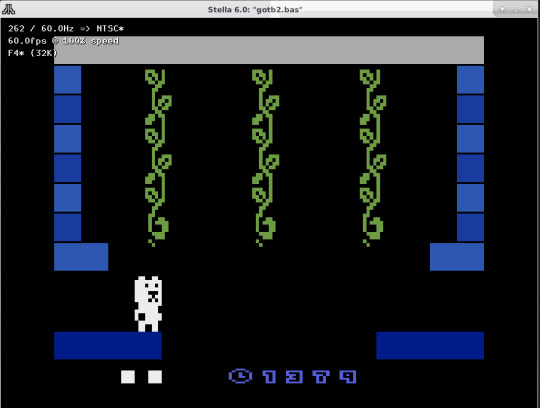

Game of the Bear 2 Much to Bear. (Atari 2600 & 7800 version)
You can play his game here: VCHZ Itch.io
2) Victor Parada, a Programmer with experience, and an indie Homebrew developer by hobby, like to create a game for Atari 800 in an optimized way and he write his games in Assembler with 10 lines only, he show me his recent project in an Atari 800 XL; Block Chaser.
You can play his game here: Vitoco Website



Block Chaser is still in its development!
3) Marcelo Waldbaum & Pedro Caraball , were the founders of Turbosoft in 1987 in Argentina with to Mauro Pieressa & Pedro Dominguez & In 1988 they founded TurboSoft in Chile and in with Coelsa company (official Atari hardware & software dealers) developed and they sold various products for Atari 800, maybe they are the first software and hardware developer in our country.
They developed:
- Loading Game with System and Error detector for Cassette (DCE) while loading a game you could play Tubo Tennis (before that Namco patented the mini-game in the loading screen for PlayStation games)
-Otari (a machine that copies cassettes)
-Cassette with 6 games for play in 1991
-Loading Software Injektor (reduce the time of load to 45 Seconds, before the cassettes, were take between 5-8 minutes to load the program
-Turbo Cartridge of 64K (between 9 to 25 games)
-Turbo VHS, you can play videogames in VHS (yes, read well in VHS)
-Revista Turbo News (1989-1991) a magazine about games and Hardwares of Atari with advertising of Coelsa.





I suggest watch the documental in Spanish of Frognum on his Youtube channel: Here
3) Robert Jaeger, the legendary indie game developer famous for making Montezuma Revenge published by the legendary Parker Brothers in 1983 for Atari 2600, 800, Commodore 64, etc, gave us a preview of his next new projects and answers us via live broadcast of our question.


Recently he launched the Version Montezuma Revenge for NES programmed by Felipe Renaud, who was written the game in Assembler (Felipe Renaud is a Chilean Programmer, who currently working at UbiSoft), Robert Jaeger has founded Normal Distribution LLC his new game company, and they made a Kickstarter for Montezuma NES in 2019, and the game packaging and Manual was designed by Alejandro Cobelli (Youtuber of "Juego del Recuerdo").


Recently Montezuma Revenge's has a new version was released on Steam, Nintendo Switch, and Mobile devices.
Also, I met with José Bargas, who is working with Robert Jaeger on an update called Director Cut, he made Montezuma Maker, a Romhack of the original with more rooms of 16 K to 32 K (an expansion of the original in resume).

youtube
Montezuma Revenge for Atari 800 was released by Parker Brothers, but in our country, we received the unfinished version, a copy, when Robert Jaeger was looking for a publisher with the Demo and finally this was filtered from the CES 1982, which was the most popular version for the Chilean users of a Atari 800.
During the day I met with old friend, how I met some youtubers of my country.




3 notes
·
View notes
Text
My Thoughts On: Virtual Console
I don't think I've done this yet?
Hey there, it's Alex! Wow, seems like all my blog posts are about a decade late to the discussion? I mean, even the whole idea of a blog like I'm running feels dated in a bygone era. Oh well, i don't really care, this is fun!
I love Virtual Console! The idea of playing all your favorite older games digitally on a more modern console at a fraction of the original price is revolutionary! The Virtual Console brand started with the Wii Shop Channel where you could purchase them using Wii Points (that's a whole topic unto itself) for previous Nintendo platforms, such as the NES, SNES, and N64, but some third-party support came in the form of Sega's Master System and Mega Drive/Genesis, SNK, and even Commodore 64, what? They had some pretty niche games on here, but also many of the biggest titles like all the 2D Mario games, Metroid, Zelda, pretty much anything you could ask for! They were missing some classic N64 games like Banjo-Kazooie for obvious licensing reasons with developer Rare's acquisition by Microsoft, and GoldenEye 007 which recieved a Wii remake. Other games like Earthbound or Panel de Pon weren't available because they hadn't yet reached the level of popularity they hold now (especially in Earthbound's case).
Quick tangent here, but I still think the DSi should have gotten Virtual Consoles. I mean, it already had an eShop! There were DSiWare games being developed just like WiiWare games! Plus, they removed the famous Gameboy Advance slot (or "Slot 2" as it's officially called), so this would be the perfect opportunity to make users repurchase their favorite GBA games, and maybe GB/GBC games that were previously unplayable on the DS, and install them on the DSi! They probably could have squeezed NES and maybe SNES VCs on there too if they tried. This was such a huge missed opportunity that would've added validity to the DSi, and could've truly pushed the DS to being one of the best consoles ever, even more so than it is now. But I digress, moving on!
After the Wii came the 3DS, sporting the 3DS eShop and, you guessed it, portable Virtual Console! Yes, finally, handheld VC titles! The 3DS ended up having Gameboy, Gameboy Color, Gameboy Advance (exclusive to Ambassador Program), NES, SNES (New 3DS only), Sega Master System, and Sega GameGear.
The GBA Virtual Consoles only had a small handful of titles released alongside the eShop, and were only available to download for free by members of the Ambassador Program, users who bought their 3DS systems before the price was cut a few months after release. They later introduced SNES Virtual Console, which is amazing! But instead of putting in effort, they said "Oh, uh, the old 3DS isn't strong enough to run SNES games, you need a NEW 3DS" and really? Is it too weak? You mean if I open my original model 3DS right now I won't see a fully functional homebrew SNES Virtual Console collection? Really? Moving on...
After the 3DS, Nintendo quickly released the WiiU as their new home console! This too featured an eShop, and Virtual Console! This time, GBA was available to everyone! They also added DS Virtual Console, which is very cool in my opinion! From what I hear it wasn't executed very well, but that's such a unique idea! They also added certain Wii titles to be downloaded and installed, sort of like a VC, but not part of that brand. Those will forever be in a state of purgatory...
And finally, we come to the Nintendo Switch, and... nothing. Nintendo has completely done away with the Virtual Console brand, and broken my heart. Instead, if you sign up for Nintendo Switch Online, their online gaming service, you get access to NES and SNES apps loaded with a bunch of retro games, but most of them are just random things most people don't care about. If you upgrade to the NSO Expansion you get N64 and Sega Mega Drive/Genesis apps, but again, so far there's just not enough games to warrant the huge price jump of the Expansion. So far there's not a whole lot of value to the service, and we're still waiting on more to justify it. Personally, I'm thinking GameCube would be good candidates for this line, and a GC app would make me instantly upgrade!
As a more recent update, Gameboy was added to NSO, and Gameboy Advance as a part of the Expansion! This is a great step forward, but its not everything they need to add value to the Expansion. Still, good job, Nintendo!
The Virtual Console name has a lot of history to it, and a lot of fond memories from gamers such as myself who remember downlaoding and playing all sorts of games on Wii and 3DS from older consoles. Today, as the brand has been done away with on Switch, and the 3DS/WiiU eShops closing, it seems that era is ending... but don't forget! With homebrew you cans till find the installable files online and put them on your console! There's also tools to make your own custom injects for the 3DS! We can still enjoy new VC for many years to come with these wonderful tools from dedicated developers.
Thanks for reading, and be sure to ask questions and suggest new post ideas in my ask box! Stay safe, stay hydrated, and God bless! Happy gaming to ya!
~ Alex
#assorted gaming thoughts#virtual console#wii#nintendo wii#ds#dsi#nintendo dsi#dsi shop#wii shop channel#3ds#nintendo 3ds#3ds eshop#wiiu#wii u#nintendo switch#nintendo switch online#nes#snes#n64#gameboy#gameboy color#gameboy advance
5 notes
·
View notes
Video
youtube
Console Racing Driving Games of 1993 - Lamborghini American Challenge
Lamborghini American Challenge is a part of the Crazy Cars series of games and was originally named Crazy Cars III for its releases on the Amiga, Atari ST and Commodore 64 in 1992.
Developed by Titus France and published by Playtronic Industrial for its SNES release, Lamborghini American Challenge released exclusively in the US for its SNES release in 1993, the game would eventually see a release outside of the US in Brazil, but not until 1996.
1. Intro 00:00
2. Gameplay 00:15
3. Outro 04:11
Don't forget to like or dislike and share all are very helpful and subscribe for more Video Game and AI art-related videos.
You can also follow me on Twitter for Video Games and AI Art
Twitter (Gaming & AI Art)
https://twitter.com/zero2zedGaming
Or follow me on Instagram for AI Art
Instagram (AI Art)
https://www.instagram.com/random_art_ai/
For more racing/driving game videos check out the playlists below
Console Racing Driving Games of 1993
https://www.youtube.com/playlist?list=PLFJOZYl1h1CFwuAaztF2yWcDR2ruiEDNZ
#youtube#lamborghini american challenge#lamborghini#racing#driving#racing/driving#racing game#90s games#90s gaming#retro gaming#classic games#1993#snes#playtronic industrial#titus france#crazy cars iii#console gaming#video games#gaming
1 note
·
View note
Text
Game Review: Transformers: Battle To Save The Earth (Commodore 64)
With the size of the franchise today, you’d expect to see Transformers video games released for every major platform on a regular basis. But that wasnt’t always the case. It took a year before the first game was released by Ocean Software for the Commodore 64 and ZX Spectrum. Another year passed before Activision took over the license and released their Transformers game, this time exclusively…
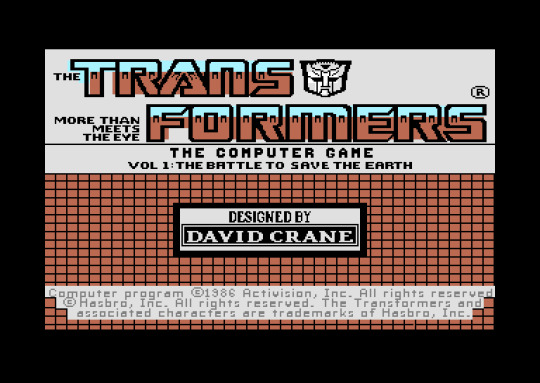
View On WordPress
#Activision#Commodore 64#David Crane#Game Reviews#Retro Gaming#Reviews#Transformers Video Games#Video Games
0 notes
Text
Video Games and Gender
My first Christmas owning a console—a pink Nintendo DS Lite—I got a couple of game cartridges. Having only been on the sidelines of gaming, playing only at friends’ houses and seeing all sorts of cool games with magic combat, cool graphics, giant motorcycles and guns, I was hyped to say the least.
I got three games that Christmas: Moshi Monsters Moshling Zoo, Moshi Monsters Theme Park, and Chess for Kids. Cue immediate deflation. Why did I get the girl version of a monster collecting game? Moshi Monsters was an often girl-marketed game as far as I understood it. Games were toys, marketed with gender in mind just as often. It didn’t help that I also got one of those game t-shirts from the girls’ section—Pikachu was on it (wahoo!) but only along with a smattering of hearts and sparkles on pink. The “girl” stuff always had to be different. Even while playing the chess game, the UI needed to know whether I was male or female. That wasn’t my parents’ fault—nonetheless, I felt a bit boxed in.
Why was it so important to have a defined gender in these games? Why did the game often get to choose for me? Why did only types of games allow you to play as a girl (or have it as the only option) while some genres were entirely male player-characters (PCs hereafter)?
When I went over to my friend Derek’s house, I could see a world of games entirely different from mine. First off, there was the violence, always coming from male characters. I don’t think I actually ever saw a gender selection screen on any of his games, unless counting the rosters of fighters like Dragon Ball. We had Minecraft and Fossil Fighters in common of our personal game collections, and Fossil Fighters didn’t have a gender selection. Instead, you would choose your favorite dinosaur and get an outfit of its color scheme. You could be pink if you liked the Maiasaurus. Just not a girl. Fossil fighting was for boys, though ironically two other main characters and fighters are young women. (This was fixed in the second game).
There is a strange limitation in effect of many video games. Nowadays, there’s of course more variety—many games, especially role-playing games (RPGs) will offer a character creation bit or a vague gendered selection. Indie games are excellent with this, often taking care to even offer small bits like pronoun preference.
Many games do not have any choice at all, though, except maybe for name. Especially with earlier games in the 80s and 90s, you’d play as a set character or not play at all. And those characters were nearly unanimously men. Exceptions to the rule would usually be games where you could only play as a woman, which included things like Barbie. The content and genre of the games would vary widely based on the gender demographic. PCs were only men in shooter games or things like Grand Theft Auto. Games on average were more focused on adventure, yet had potential to branch out a lot. Boys could play in any sort of story. Except the Barbie games. Barbie games were Barbie games, and you could only be a blonde woman buying heels and calling her boyfriend. This was dating back to the times of the Commodore 64.
The concepts of video game adventures are generally pretty gender neutral. They end up supporting some stifling roles in limiting their adventures to male PCs when there is no reason to. Individual characters (like Ness of Earthbound, or Lara Croft of Tomb Raider) are a different case, as they place you into a single place rather than you being a random insertion into a universe. After a while, though, when you only hold an assault rifle in the hands of a male character and care for animals in that of a female character, there are implicit lines being drawn. Violence is for men. Caring is for women. Women play one role, men another. Binary, exclusive distinctions in the gender roles of characters are damaging, even if you might not take it to heart too much.
The binary is enforced in ways ranging from unnecessary to borderline nonsensical in video games. In the latest installments of the Pokémon game series, the character creation only asks “What do you look like?” with presentations of male and female character options, but if you choose a female character you will be referred to as “Mistress [Name]” by the school’s principal, and “Master [name]” if you play a male character. It’s the only difference, aside from visual, in the game from the player character’s appearance. I am also of the opinion that it is weird to call a school-aged person ‘Mistress’. Strange.
Another example from Pokémon (I play a lot of Pokémon) is a niche, still odd example found in a hidden sort of mini-dating sim in the White 2 and Black 2 versions of the game from 2012. Walking onto certain spots of the map after picking up a lost calling device triggers a series of phone call conversations. The gender and dialogue of the caller change depending whether the PC is a boy or girl. The caller is always the opposite sex: Yancy calls you if you’re a boy, and Curtis calls the girl character. Their dialogue not only differs in their personality…only the men get to talk about themselves! I’m not kidding. Though you can’t read any dialogue from the PC during the calls, if you’re a boy, Yancy only responds to what you say, barely (if ever) saying anything from herself. Curtis will talk your ear off.
Here’s examples of the differences between the same conversations, with the different callers:
Yancy:


Curtis:


It is as insufferable to play as it is to read. Though it’s silly looking, it still supports a standard of men always taking the initiative, and women being receptive conversation partners and always going off of or listening more to what the man is saying. There isn’t even a reason to really have this difference, as since the player has no dialogue options to choose, they can’t really talk about themselves. I wanted to hear Yancy’s favorite type of music too, but all she says is “I like music too!”. Horrible.
These kinds of arbitrary limits and differences are all over the place in games, and though they seem unserious sometimes at face value, they quietly (…or less quietly) reinforce “dos” and “donts” for players based on their gender. In Fire Emblem, only males can axe-wield until the fourteenth installment of the games. Men can’t be Pegasus Knights because they are considered too provocative for the skittish creatures…while literally all women are calm enough, apparently.
There are always arguments of gender differences in games being ‘realistic’, contributing to the suspension of disbelief in gameplay by anchoring mechanics to real world truths. The key takeaway I want you to have from reading this is that not a single gender difference is absolute in this world. Not a single one. There are trends—many people raise their children in separate ways, subtly or unsubtly, based on their assigned sex—in cultures, eras, geographical location, the list goes on. Nonetheless there always exist people outside of the standard. The standards of gendered behavior and general constitution are shaky at best, and fictitious at worst. Women are not inherently more receptive or docile, they are raised to be, so some may have more of that sort of personality by virtue of any sort of influence or personal disposition. They can also be literally anything else. Liking pink or blue, guns or glitter, pegasi or dinosaurs or whatever aren’t wired into anyone’s chromosomes, and neither are their personality traits for the most part.
The prevalence of these sort of tropes create an uncomfortable environment for many gamers that aren’t men that fit the bill of the expected audience. Men may not care as much that men and women’s stats have opposite strength profiles in Fire Emblem for the most part. A female player would likely not want to play games where she is at a set disadvantage solely for picking the character with eyelashes, or where choices are limited based on that initial character choice. Many people enjoy immersion in games, and when that immersion mimics and reinforces real life sexism, video games become understandably less attractive. If the only women in a game are sex objects, it’s not really as fun anymore to play as a woman, knowing that’s the place of women in the world of the game.
Unfortunately, these strange standards are mirrored onto playerbases quite often. Especially with chronically online gaming folks, the separation of the functions and abilities of men and women gets downright absurd, and can reinforce already prevalent misogynistic stereotypes. And with all that, some come to think: what women would even want to play games then?
Aren’t these just a dude thing?

And so the cycle continues.
People of all genders and backgrounds have infinite potential, on and offscreen. When games refuse to represent that--or worse, refuse its possibility outright by their mechanics--they perpetuate the cycle of restricting peoples lives by arbitrary elements of their identity.
0 notes
Text
AITech Park Interview with Osmond & Dave at Intelligent CloudCare

Explore the forefront of AI technology in our exclusive AITech Interview with Osmond and Dave, experts from Intelligent CloudCare. Unravel the potential of intelligent solutions and their impact on the future of businesses.
Please tell us a little bit about yourself and your role as the manager of Intelligent CloudCare.
Ozzie – As far back as I can remember I’ve been surrounded by computers and technology. It all started with my aunt’s Commodore 64 PC when I was in my youth. I found it fascinating. There’s a quote from the movie “Ferris Bueller’s Day Off”, “I asked for a car, I got a computer.” My situation is relatable. When I became old enough to drive all I wanted was a car. Instead, I received a new IBM PC.
I started my professional career in 2001, as a bench tech for a local IT solutions company. Since then, I’ve played varying roles, across a multitude of teams, ranging from higher education and medical billing to manufacturing and industrial design. Needless to say, it’s been quite a journey! These experiences showed me just how much technology is interwoven with so many aspects of our daily lives.
My current role, as the Sr. IT Manager of Intelligent CloudCare, is by far my favorite. I’ve been given the opportunity to develop a team and oversee the day-to-day operations, as well as grow the Intelligent CloudCare brand.
To Know More Visit: https://ai-techpark.com/aitech-park-interview-with-osmond-dave/
Visit AITechPark for cutting-edge Tech Trends around AI
0 notes
Text
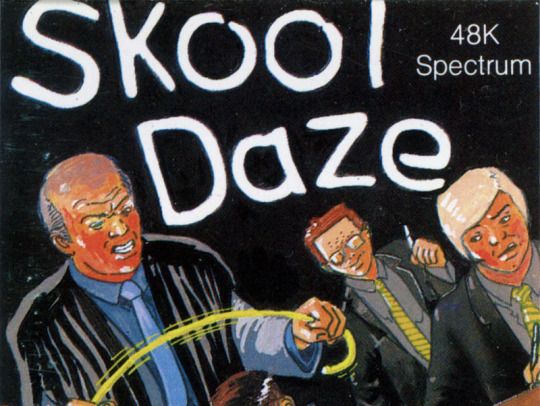
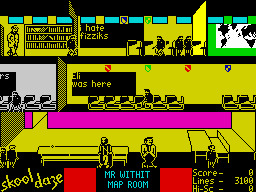
Skool Daze (ZX Spectrum)
Developed/Published by: David Reidy, Helen Reidy / Microsphere
Released: 12/1984
Completed: 18/07/2022
Completion: Went up a year!
Trophies / Achievements: n/a
What I said a couple of weeks ago about Soccer on the NES being worse than a Spectrum game had me suddenly thinking if there was anything particularly important I’d missed as I work my way forward through the years, and while there are some things here and there I might go back to, one release caught my eye: Skool Daze, released at the tail end of 1984 and 15th on the Insert Credit Best British Games Spectacular.
Skool Daze is a game that–if I’m being completely honest–I’ve played more in its first retro remake, Klass of ‘99 (which is now older than Skool Daze was at the time of the remake, but let’s not think about that) because it’s one of the rare(-ish) games that was released on ZX Spectrum and Commodore 64 but that never actually made it to Amstrad CPC. That means for me it was a game that (although it was well in the class of “crusty old budget games” even when I got my Amstrad) I simply pined after having read about it in multi-format magazines. In fact, I can literally remember looking at an advert for Alternative Software’s budget range of I think £1.99 games with each game with a wee checkbox for Spectrum, C64, CPC, and genuinely being disappointed about how unfair it was there was no checkbox for CPC next to Skool Daze. It’s funny the mundane things you remember.
Skool Daze is also one of those games that, in whatever format I’ve played it, I’ve simply messed around with, with no actual attempt to efficiently finish it, until now. If you’re not familiar with it, it’s an early school… simulator? Sandbox? It’s the kind of game that I think of as quite exclusively British, honestly–messy, over-ambitious, and not simply interested in using systems to create emergent play, but to do so in a way recognisable to its audience. I’d love to be able to pinpoint when this kind of game design went truly fallow in the face of more strictly narrative or linear experiences, or if it was truly always just the domain of the iconoclast, where it remains to this day.
(If you were to push me on it, part of me thinks the phenomenon of Doom was the end of any future where games could concentrate on being simulation sandboxes; for me, Doom was a step back from Ultima Underworld. Yes, I still want to talk to the monsters.)
Anyway, in Skool Daze, you play Eric (who can be named whatever you like, as with all of the other characters–a spark of genius allowing its schoolboy audience “recreate” their own experiences) who, aware his report card is a complete disaster, must steal it from the school safe in order to (I assume) doctor it. To do so, Eric has to first, uh, make all the shields that hang around the school start flashing by hitting them, which, uh, makes all the teachers reveal their secret code letter for the safe, apart from Mr Creak, who can’t be trusted with it (so was… um… hypnotised) and will only reveal it if he sees his birthdate drawn on a blackboard. Then you write the code on a blackboard, nick the report from the safe, and hit all the shields again!
What I sort of love about that completely deranged task list is how clearly it comes from the limitations of making a game on a Spectrum and also (honestly) the fact that the developers (David and Helen Reidy and Keith Warrington) were clearly more interested in making a school sandbox than a strict video game experience. Surprisingly (after playing things like the willfully obtuse Tower of Druaga) here they actually explain exactly what you’ve got to do in the cassette inlay–not so helpful if you’ve pirated it like everyone probably did at the time, admittedly, so I wonder how many players really did just play it as a sandbox survival!
What makes it actually interesting, of course, is that whether or not you’re actually interested in finishing the game is the simulation of a school day. You’ve got classes to get to, teachers and other students follow their own routines, and you can’t just do whatever–if a teacher sees you hit another student, or use a catapult, you’ll get lines, and if you try to skip a class they’ll pursue you doling out hundreds of lines what feels like every second. And in class, there’s often not enough seats, leading to yet more lines as students turf you out of your seat onto the floor.
It’s a fascinating experience, if a challengingly dated one. It’s honestly not any worse to control than Soccer on NES, but it does have its quirks–I remember playing games with QAOP movement, but it’s amusing to see how unintuitive the “intuitive” decision to place actions like jump on “J” and firing your catapult on “F” is. It’s just a bit… fussy. Going up and down stairs is a challenge, and your catapult is extremely temperamental–you can’t fire too close, or too far, and you miss sometimes anyway in a way that feels like a bug, but I suspect is some calculation being made that you missed instead of hit (though that’s pure speculation as there’s no feedback.) But the game is a clever take on a stealth genre that didn’t really exist yet–you can get away with stuff if a teacher’s back is turned, you’re far enough away, and especially if another (named) child is closer to the teacher as they’ll get the lines instead. Important, because you get expelled as soon as you hit 10,000 lines, which is honestly very easy as teachers randomly assign you between 100 and about 800 lines, making some mistakes very costly.
The game even has events, which is surprising–sometimes the swotty kid goes to tell on you and you have to stop him (by punching him a lot out of the view of teachers) to stop yourself getting lines; other times you’re stuck trying to avoid the bully who has mumps (annoyingly this causes an instant game over). Along with all the lessons having the teachers actually talk about stuff, there’s a surprising amount of stuff in a game intended for a stock 48k Speccy!
Actually completing it though… hmm. I’ll say here that you’re going to have the most fun with this just messing around with it or even treating it as a survival score attack; hit as many teachers and kids as you can, survive as long as possible. Completing it is simply a bit too exacting and I’m not going to lie that after a bunch of runs I gave up and started using save-states. You see, the game might allow you to really complete it in any fashion you want, but unless you want to poke the game’s memory to limit the number of lines you get (beyond me) you really have to complete the game quickly to not die from lines, making any completion feel like a very exactly speed-run. The school design doesn’t especially help–the top floor all shields can be hit by leaping but the bottom floor requires you hit teachers to bounce your catapult ammo off their heads to hit shields, and if you don’t time it exactly right you’ll get lines and no benefit.
Worst is the middle floor; you can hit teachers or punch students and jump on them to hit the shields, but the majority of them are in a dead-end exam room that is almost always empty. As a result you’re probably going to have to skive a class to get in while another class is in there, and because the school isn’t loopable, avoiding a teacher for long enough to get to the next period (at which point they lose interest) is next to impossible.
(My caveat here is it might be possible to play the game slowly, very carefully, but there’s so much simulation randomness that you can suddenly find yourself stuck getting knocked down by the bully in front of a teacher, getting thousands of lines…)
So the game does sort of devolve into a puzzle if you try to complete it, but I think in 1984 playing the game a lot, learning the timetable, seeing how teachers would move around, would have made this a perfectly enjoyable puzzle, and it’s simply that in 2022 I don’t want to have to restart the game again just because my stupid catapult missed or I was one nanosecond too early with my hit to actually get the shield meant I turned to the easy way out.
I won’t lie; this is a hard game to play now, but I also won’t lie that I played it for hours. Occasionally frustrated, but always entertained by the little school dramas being played out in front of me.
Will I ever play it again? No, but I’ll be checking out Back To Skool for sure and might even look at Klass of 99 again, which pretty heavily changes things in a way I didn’t even remember at the time (it might use the Back To Skool school layout? I’m not sure.)
Final Thought: Skool Daze has a modern remake as well that I didn’t know about until writing this up, Skool Daze: Reskooled, but it is absolutely horrendous looking, with horrible art and animation. Which probably sounds a bit rich considering I just spent hours playing something with four frames of animation and heavy color clash, but seriously, just look at it. Bleurgh.
Support Every Game I’ve Finished on ko-fi, either via a one-off donation (pay what you like) or by joining as a supporter at just $1 a month and get articles like this a week early.
2 notes
·
View notes
Text
Unusual Findings delves into the unknown with support

Unusual Findings game of amazing adventures has a Linux and Mac build with Windows PC. All due to the efforts of developer Epic Llama Games. Which has been available on Steam, since November 2022, while offering 80% Very Positive reviews.
Jump into an amazing adventure inspired by the synthwave, neon lights, and 8-tracks. As well as cult classics of the era such as The Goonies and The Lost Boys. While you embark on an Unusual Findings journey that leads the boys to a chilling discovery of an impending alien invasion. Every choice you make affects the world around you. Since sweet talking can be the difference between life and death just as much as when you let your fists talk for you! Your choices will also affect your relationship with your friends. This determines how the story ends, so get ready to sharpen your detective skills!
And we also worked day and night to polish and release versions of Unusual Findings for macOS and Linux. This, of course, was in the plans, but only now we were able to get to it properly and fully release these versions. Hurray! ^^
Naturally, there are many other minor fixes, including some bugs that have been eliminated (we hope that's all, but if you come across those that we haven't caught, be sure to write to us!).
This is from the Steam Post from November 28th, 2022. But still, playing the Windows build brought a need for Linux. As a result, Epic Llama eventually offered a native build of the Unity 3D game.
Christmas is coming. Vinny, Nick, and Tony are trying to decrypt a pay per view adult channel. Doing so with their brand new cable signal descrambler. But somehow they pick up the distress signal of an alien spaceship. One that is crash-landing in the woods near their town. Things only get weirder as they realize that the towering alien is killing specific members of their community!
Unusual Findings - Official Launch Trailer
youtube
Immerse yourself into a Unusual Findings world and gameplay that combines the mechanics of a classic point and click adventure. Such as Full throttle, but with its own unique twist.
Check the Video Buster Store out for clues, challenge other kids at the Laser Llamas Arcades. You can also try to get along with the Lost Boys with their punk aesthetic in their hideout. Each decision you make in Unusual Findings affects the relationship between the three friends. As well as the entire story. Changing the way they solve each puzzle, how they visit each location and the answers they find.
Features:
Follow the Sci-fi coming of age story of three friends fighting together against the unknown… things. Maybe against some known things too.
Utilise “see”, “grab” and “talk” action tokens, take advantage of an Unusual Findings inventory. While you use and combine items as well as your wits. All you need to play the game.
Stylized Pixel art. All the charm of pixel art of the past with more colors. These are combined with the new visual effects of the future. Some pixels look so real they can almost jump out of the screen.
Go back to a simpler time when mixtapes were a thing, the Commodore 64 was king. Kids could go play outside at night and the only main thing of concern was the giant KILLER ALIEN trying to get you and your friends.
The decisions you make in Unusual Findings affect relationships between each of the characters. Thus by extension the puzzles, game progression, and story. Choose wisely.
The most radical music a synthesizer can play. Cool and thematic synthwave music is arranged into catchy tunes that are made exclusively for the game. All due to power up the 80s vibes for full immersion.
Unusual Findings is a game of amazing adventures for Linux, Mac, and Windows PC. Available on Steam, priced at $19.99 USD / £16.75 / 19,99€.
#unusual findings#amazing adventures#choices matter#linux#gaming news#epic llama games#ubuntu#mac#windows#pc#unity
1 note
·
View note
Text
Learning DefleMask... 's legacy version
This ended up a bit longer than I hoped.
So far, I've made my music exclusively in MilkyTracker. Unlike programs like FL Studio, you don't have a fancy graphical overlay and not that many options. That's because trackers have been around for a very, very long time, and they weren't exactly made for mass consumption.

What you see is what you get.
You've got your instruments and samples (per instrument) at the top, then some fancy graphs, and the main feature takes up the majority of the screen: Your (up to) 32 channels, column by column. You're basically making music by filling in spreadsheets, called patterns, and arranging them. Their order is in the top left corner.

Things can get quite busy, so let me break things down a bit. This will be useful later.
While playing a track, the pattern is scanned row by row, top to bottom. To be brief, the white value is the new note (it continues the previous note if it's empty), blue is the instrument number, green represents the volume and the last three numbers are the effects column. What effect each code stands for is pretty much a standard at this point. Don't worry about the values themselves, I don't either. I just play around a bit and whatever sounds best is usually what I choose.
This is what I've used for three years now, and I still will. MilkyTracker allows you to play anything on any channel, so it's great for making music overall. But what if you want to emulate a particular sound, like the Sega Genesis or the Commodore 64's iconic SID chip?
This is where DefleMask comes in.

This tracker is designed to simulate particular soundchips from back in the day. You can create tracks for the GameBoy, NES, C64, and numerous Sega consoles. For testing I'm only using the free legacy version, and the number of emulated chips has grown slightly since then!
I'm especially interested in the aforementioned Genesis and Commodore. I love each console's chip for their own reasons. The SID was simply amazing for its time and the Genesis provided many memorable tunes (that's neither exhaustive nor mutually exclusive!)
I cover stuff, so to explore this new environment a bit I decided to cover make a Genesis cover of the Hidden Theme from the C64 game "Dominator":
youtube
Matt Gray produced a lovely track here, the guy's a very talented SID composer.
I already covered the same game's Loader theme - this was the Commodore 64 after all, loading took a while - so I roughly know what I want things to sound like. Except this time I'm using DefleMask.
Where are things currently? I'm about 38 seconds into the track, and I've already noticed a few things that I really like about this program.

Overall, I think the way things work in DefleMask is... tidier? I don't have to specify the note volume once, and fades are controlled by the instrument's volume envelope (ADSR). This means far less stuff on the volume and effect columns. Speaking of which, I can have multiple effects per channel, which you can even see in this screenshot!
However, there are some challenges as well. It's not the tracker's fault that hardware worked that way, but the speed of the track is not as controllable. I can set the "length" of one row and I can change the clock speed. That's it.
How exactly the instruments are made goes beyond this post, I think. Maybe I'll add more later, the key phrase here is "FM synthesis".
So far, I think DefleMask is very comfortable to use. It took a few hours to adjust, but now I somewhat know what I'm doing!
Lastly, since I've already mentioned it, I might as well share what I've got so far. This everything I got "done" in one day, including learning how to use the tracker at all. It goes without saying, but this is heavily work-in-progress and things sound a bit unpredictable at times. Of course things will improve with practice.
youtube
0 notes
Text
Pixel Art
Welcome back to the blog, last week we covered Pop Art and some of the notable artists that helped shaped that medium, and today we will tackle the ever-evolving art form of Pixel Art.
What Is It?
Pixel art is a distinct style of digital art that appears to have been purposefully constructed by the positioning of pixels. Each block is a brushstroke, and the pixels work together to form a cohesive artwork. In this sense, pixel art has a mosaic-like feel to it, as many mosaics generate images of tiny squares, which are akin to the blockiness of pixel art. This is such an intriguing feature because, while the notion of minimalist grid-based art isn't exclusive to pixel art, it may be the most identifiable.

Along with the standard form of pixel art that most people understand already, there are a couple of significant genre and subject breaks in this art form. Pixel art is a very flexible medium, and shares many traditions of figure drawing, landscapes, and abstract with traditional media. These genres can often overlap and can be hard to distinguish to the casual viewer, but a couple more prominent genres are:
Isometric: Pixel art drawn in a near-isometric dimetric projection. Originally used in games to provide a three-dimensional view without using any real three-dimensional processing. Normally drawn with a 1:2 pixel ratio along the X and Y-axis.
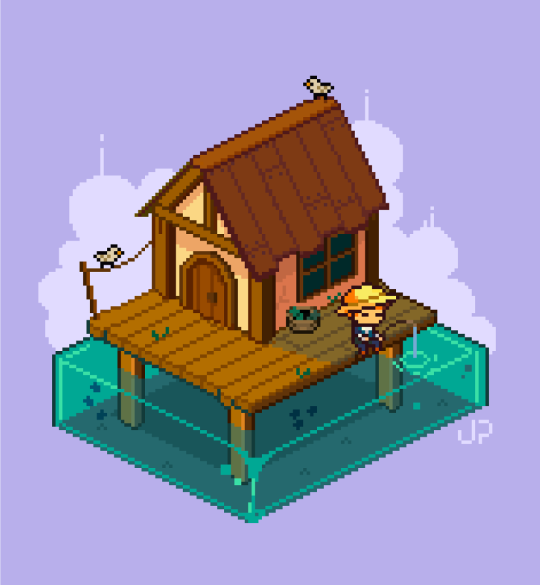
Sprites: Characters and game assets typically drawn in the fashion of platformer games and fighting games such as Streets of Rage or Streetfighter 2 or JRPGs (Japanese Roleplaying Game) such as Final Fantasy.

Along with the many genres/subjects, there are also several techniques that have become common in the creation of this form of art. Many of these strategies were developed in response to technical constraints, but have withstood the test of time. Some emerged and evolved during the span of Pixel Art's existence. Pixel art is distinguished from other types of digital art by the precise and planned positioning of pixels. Artists employ various brush sizes (e.g., 1x1 or 2x2 pixels) and tools such as free-hand / pencil, lines, and rectangles.

One key difference between pixel art and other digital art is that pixel artists tend to apply a single color at a time, avoiding tools such as soft edges, smudging or blurring.
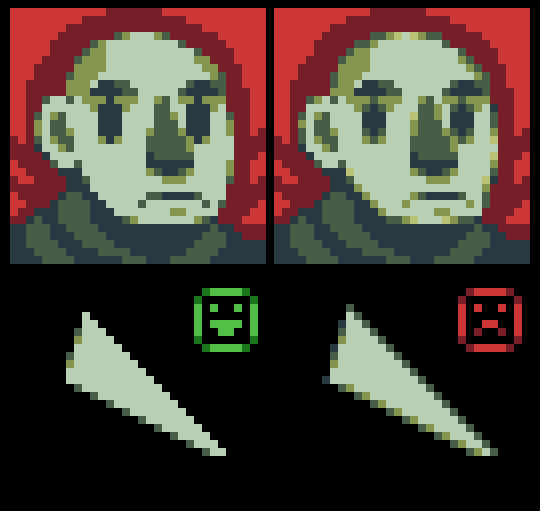
Different restrictions are central to pixel art, and these are often traced back to technical limitations of hardware such as Amiga, Commodore 64, NES or early computers.
Origins and History
Pixel art may be most commonly associated with the rise of video games, however that was not it’s starting point. Some of the earliest examples of pixel art could be found in analog electronic advertising displays, such as the ones from New York City during the early 20th century, with simple monochromatic light bulb matrix displays extant circa 1937. Pixel art as it is known today largely originates from classic video games, particularly classic arcade games such as Space Invaders (1978) and Pac-Man (1980), and 8-bit consoles such as the Nintendo Entertainment System (1983) and Sega Master System (1985).

Video games were beginning to emerge in the entertainment industry by the early 1970s, but due to the severe limitations of early graphics, the first instances of pixel art in video games were somewhat abstract. Because of the poor resolution of computers and game consoles, game designers have to meticulously build game assets by painstakingly placing individual pixels to make recognized symbols, characters, or things. It wasn't all bad however, as abstraction, such as Pong's very simplistic design, sometimes resulted in better game readability and commercial success than trying more detailed realistic art.

The 1980s witnessed a period of innovation in video games, both as a new artform and form of entertainment, in what is frequently referred to as the "golden age of video games" or "golden era of arcade video games." During the early 1980s, most video game developers were programmers rather than graphic artists. As technology advanced, commercial pressure increased for more representational and "realistic" images in video games. As graphics technology advanced, it became feasible to substitute hand-drawn game elements with imported images or 3D polygons, contributing to the development of pixel art as a distinct art form.

Professional artists and graphic designers gradually gained a larger presence in the video game business. The style of 1980s video games has a significant influence on current and future pixel art, both in video games, demoscene visuals, and among independent artists.
As computers became more affordable in the 1980s, software like DEGAS Elite (1986) for the Atari ST, Deluxe Paint (1985) and Deluxe Paint 2 (1986) for the Commodore Amiga, and Paint Magic for the Commodore 64) inspired many subsequent pixel artists to create digital art through careful pixel placement. Some early pixel artists utilized joysticks and keyboards to pixel on the Commodore 64 and the Amstrad CPC.

8-Bit vs. 16-Bit
One major question that is often brought up in regard to Pixel Art, is the difference between 8-bit and 16-bit graphics. First off, in terms of the time period, the 8-bit era spanned 1983 to 1987 while the 16-bit era lasted from 1987 to 1993. If you’re totally unfamiliar with what 8-bit and 16-bit are, it, in part, refers to the tonal variation of the image. An 8-bit picture, for instance, will have fewer amounts of tones available for each color than a 16-bit does. The more color tones available, the more detailed that you can get with your image-making. The bit in 8 or 16-bit refers to the capability of every pixel to use 8 bits for storing the amount of colors that can be displayed. That results in 8-bit graphics being capable of displaying a maximum of 256 colors, while 16-bit can go as high as 65,536 colors.
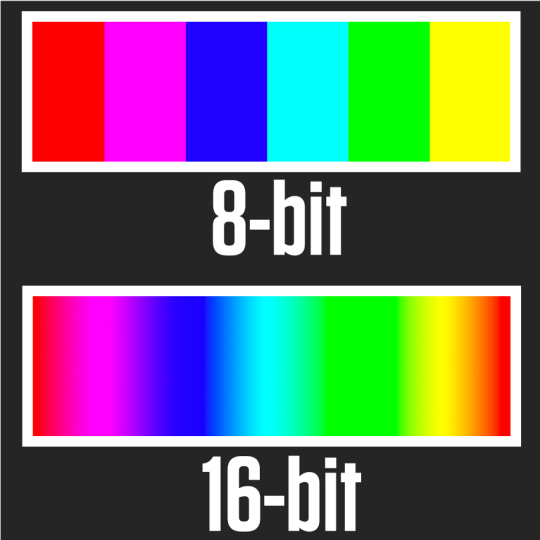
The Fall and Return of Pixel Art
Pixel art declined as software quality increased and new, 3D-capable systems such as the Sony PlayStation and Nintendo 64 were introduced. Pixel art lost its broad presence with the advent of contemporary technology, advanced computers, and 3D graphics, primarily in the realms of consoles and gaming, however, contrary to common assumption, it did not fade away.
By the mid-2000s, 3D graphics and gaming had become the standard, with pixel art regarded uncommon and archaic. This new image sparked a resurgence and respect for its 8-bit values. Many feel that pixel art games have made a resurgence due to nostalgia as the simplicity, minimalism, and lightness of the pixels, as well as the way they remind us of our childhood, make them so appealing.

Although it was never thought that pixel art would go beyond its virtual, cyber depiction, enclosed within a computer screen, it did, in the name of creating tangible artworks. Pixel art spread to other aspects of life, with artists creating pixel art posters, magazine covers, music album covers, desktop wallpapers, paintings, pixelated video advertising, and even pixelated tattoos. They were born pixel by pixel through this one-of-a-kind method of expression, borrowing influence from pop culture, the news, design, and more.
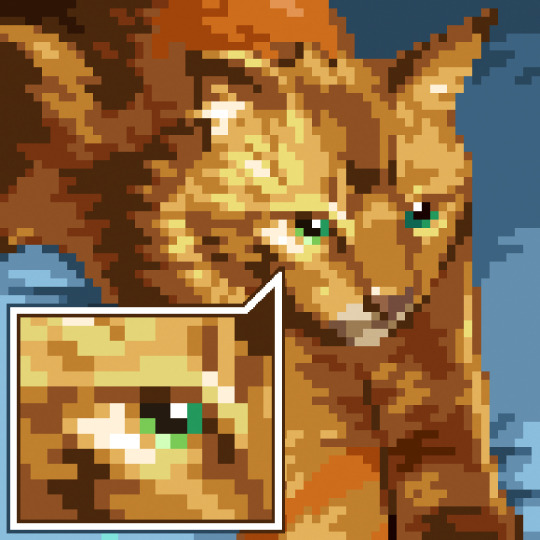
Artists
eBoy
With the rise of Pixel Art, also came its prominence in the art world, separate from its traditional view as strictly being reserved for video games or video displays. One of the artists, or in this case, group of artists that led to this evolution was eBoy, a collection of three men, Kai Vermehrr, Steffen Sauerteig, and Svend Smital. They may be the most famous group of pixel makers out there and are often affectionately reeffered to as “the Godfathers of Pixel”. These guys are famous for their complex illustrations called Pixoramas, city and landscape scenes pixelated, of course, on purpose. To date, they have made pixoramas of places like Tokyo, Paris, New York, Rio, Berlin and London, and are currently Kickstarting the one for San Francisco.
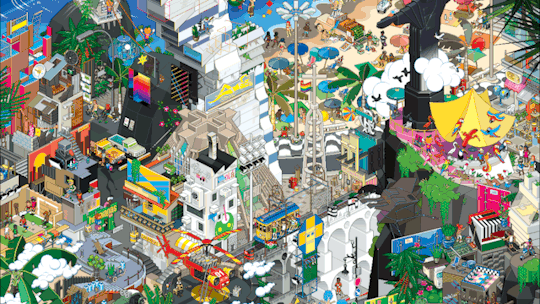
Invader
Another prominent pixel artist is the French urban artist who goes by the name Invader. He is known for his ceramic tile mosaics modeled on the pixelated art of 1970s–1980s 8-bit video games, many of which depict the titular aliens from the arcade games Space Invaders, Pac-Man and Super Mario Bros. (the inspirations for his pseudonym). As of December 2020, his real name is Franck Slama, his creations can be seen in highly visible locations in 79 cities in 20 countries. To accompany his citywide installations, or "Invasions", Invader publishes books and maps as guides to the locations of his mosaics.
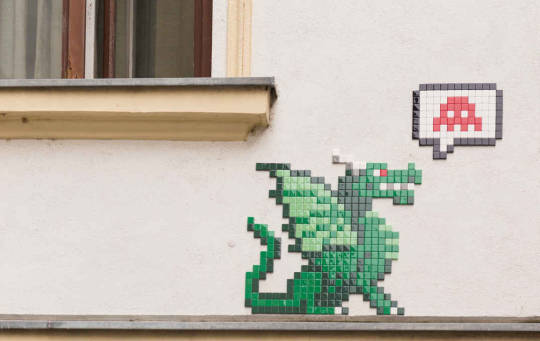
In Conclusion
Pixel art is unlike any other art form, and that is likely due to its more unique origin. Deriving from video games and being an inherently limiting art form has led its artists to getting creative to create some of the most beautiful and retro looking art possible. Thanks for reading, come back next week for our final subject: Computer Graphics!
1 note
·
View note
Video
youtube
Console Sports Games of 1993 - Tony La Russa Baseball
Tony La Russa Baseball is the second entry in the Tony La Russa series of Baseball games from the 90s and is one of only two in the series to appear on home consoles, all other entries were either on the Commodore 64, MS-DOS or Windows.
Tony La Russa Baseball was released exclusively on the Sega Genesis in 1993 and released exclusively in the United States. Tony La Russa Baseball is the final entry in the series under the development studio name Beyond Software, with the studio changing to Stormfront Studios in 1993.
Licenced with over 500 real baseball players, Tony La Russa Baseball allows you to watch your team, play as your team or if you are looking for a more strategic experience manage your team.
1. Intro 00:00
2. Gameplay 00:15
3. Outro 11:53
Twitter (Gaming & AI Art)
https://twitter.com/zero2zedGaming
Instagram (AI Art)
https://www.instagram.com/random_art_ai/
For more sports game videos check out the playlists below
Console Sports Games of 1993
https://www.youtube.com/playlist?list=PLFJOZYl1h1CEhIf6hohng9T2IPLCpzn7o
#youtube#tony la russa baseball#sport#sports#sports game#baseball game#90s games#90s gaming#classic games#retro games#sega genesis#beyond software#Tony La Russa series
0 notes